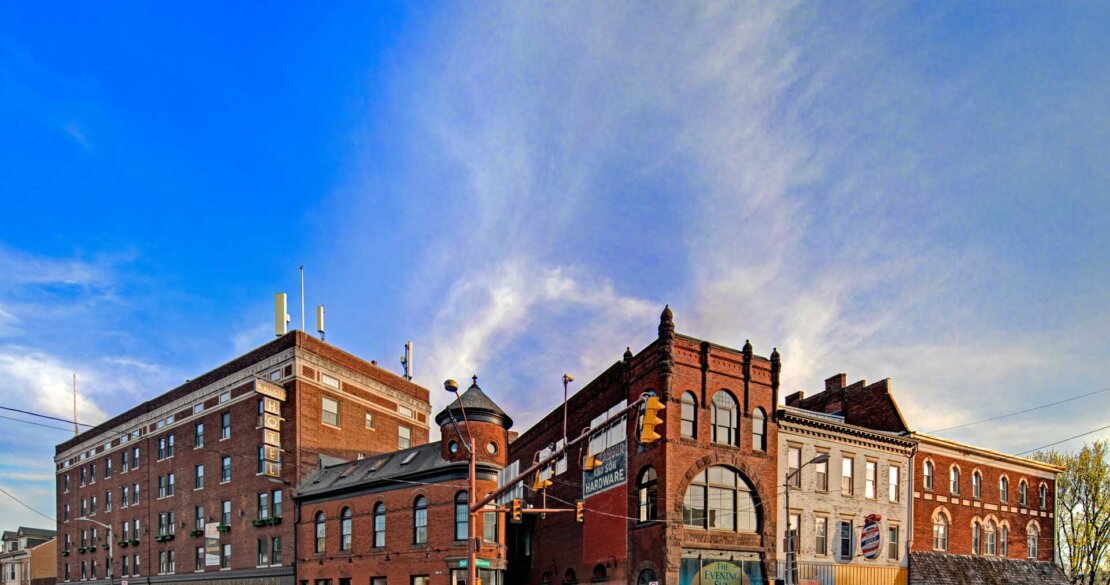Picture an old, dilapidated warehouse. It might have vines growing up its façade, broken windows, and be riddled with graffiti. Now, imagine the same structure transformed into a chic Americana restaurant with exposed brick and beams, soaring trusses, bold framework, and every table booked.
That’s the magic of adaptive reuse. Instead of leaving abandoned buildings to deteriorate, architectural designers breathe new life into them. A former factory can be transformed into a co-working space or lofts. A crumbling barn becomes the go-to venue for rustic weddings. And a warehouse is revamped into the hottest new restaurant in town.
SAAarchitects is committed to the thoughtful transformation of historic spaces. Let’s take a closer look at what adaptive reuse is, its key benefits, and how our firm elevates communities through creative and efficient design.
What Is Adaptive Reuse?
Adaptive reuse in architecture is the process of repurposing existing buildings for new uses, rather than demolishing them and constructing something entirely new. It involves modifying and upgrading a structure to serve a different function while retaining its historical, cultural, or architectural features.
Surprisingly, adaptive reuse is far from a new idea and can be traced back to ancient Rome. However, as more people prioritize sustainable architecture practices, adaptive reuse strategies have become increasingly prevalent among designers, and for good reason.
Why Adaptive Reuse Matters
Adaptive reuse has numerous benefits for developers, residents, communities, and the environment, including:
Cost Savings
Rather than tearing down an old building and starting from scratch, developers can repurpose existing materials to create a new structure or features. This saves them money on supplies, labor, and time.
Additionally, preserving historic buildings through adaptive reuse often qualifies for grants and tax incentives.
Increased Property Value and Stimulating Local Economies
Abandoned buildings can significantly reduce the value of nearby homes, with losses ranging from 7% to over 9% for properties within 500 feet and by thousands of dollars for properties on the same block.
Not only are old, abandoned buildings an eyesore, but they are also often linked to higher crime rates, making nearby properties less desirable to prospective buyers.
Adaptive reuse boosts property value and curb appeal by revitalizing abandoned or underutilized structures. Historic buildings can also be converted into new retail or office spaces, attracting a diverse range of businesses, residents, and visitors alike.
Preserving the past can also attract more renters. Many renters, especially younger ones, value the character and charm of historic buildings. And with much of the modern workforce being remote, property owners can rent out office space if they’re struggling to attract tenants to keep their buildings occupied.
Supporting Communities
Adaptive reuse can help meet residents’ needs by expanding the supply of livable space. Transforming underused commercial buildings or factories into affordable housing offers vital support to underserved communities.
By adaptively reusing old buildings, architects can also increase the urban density of a neighborhood. Many people prefer walkable communities where they can go grocery shopping, grab a bite to eat, and visit the gym, all without needing a vehicle. Reducing the need for cars, in turn, reduces carbon emissions, promoting sustainability.
Challenges to Consider in Adaptive Reuse
Despite its numerous benefits, adaptive reuse also comes with its fair share of challenges, including:
- New Building Codes: Many older buildings don’t meet modern-day requirements for safety, energy, and accessibility. Getting historic structures up to code can be tricky.
- Hazardous Materials: When repurposing old buildings, you may be exposed to dangerous materials such as lead, asbestos, mold, and PCBs.
- Flexibility: When you build a structure from the ground up, you have more freedom and flexibility with design. For existing buildings, designers must think creatively and outside the box to strike a balance between preserving original features and meeting the needs of today’s users.
How SAAarchitects’ York Designers Reimagine Historic Structures into Modern Spaces
At SAAarchitects, we help clients overcome these challenges and see the opportunities in old buildings. Our designers take a thoughtful and strategic approach to adaptive reuse and historic preservation, ensuring that we strike a balance between innovation and tradition.
Our three-step process ensures historic spaces meet modern demands, maximize ROI for property owners, promote sustainability, and support communities:
- Pre-Design: Our team documents the existing conditions of the historic structure. When necessary, we prepare applications for National Register designation and conduct research in local archives and libraries to gather historical data about the building.
- Assessment: We carefully document the existing conditions of the historic building, with a strong focus on preserving its historical significance.
- Development: SAAarchitects will create a plan to revitalize your historic site, preserving its original character while adapting it to meet your current needs.
One such example is McAllister Lofts. We provided comprehensive architectural services for the adaptive reuse of a historic 1920s hotel into 30 market-rate lofts. The interior renovation preserved several original features of the former hotel, such as the tile and marble flooring, brick detailing, the original staircase, and the decorative wrought-iron railing. Each apartment also features Craftsman-style wainscoting.
Whether you want to transform an old building into office space, affordable housing, or shops and restaurants, we’ve got you covered.
Get in touch with us today to learn what we can do for you.
